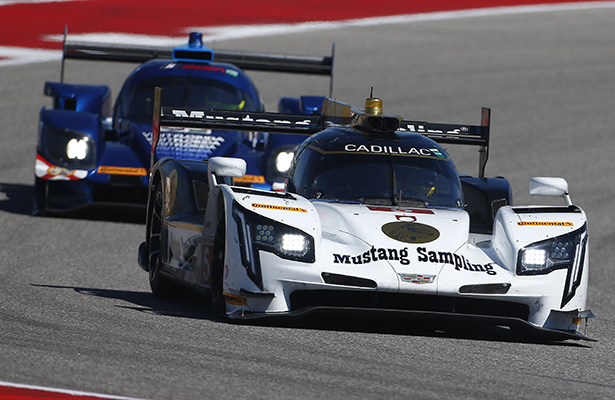
Photo: IMSA
IMSA President Scott Atherton has revealed that a separation of the LMP2 and DPi platforms into two classes in the WeatherTech SportsCar Championship is under consideration, although admitting it would likely not happen in time for next year.
A number of team owners have voiced concerns over the disparity currently seen in the new-look Prototype class, with the global-spec LMP2 cars unable to fight for overall wins, despite multiple attempts to slow down the all-dominant Cadillac DPi-V.R through Balance of Performance adjustments.
Combined with the lack of a Pro-Am driver enforcement in the class, Atherton said that a separate LMP2 category has been a topic of discussion, but with no decision having been taken for the future.
“We’ve talked about it, and in some cases great length of white-boarding it, ‘If this then what’ type of scenario,” Atherton told Sportscar365.
“If there was to be that type of a separation, the most logical configuration would be to position DPi as all-factory, all-professional and have LMP2 then become the pro-am combination.
“Right now we’re not there. I think a lot of that will have to do with critical mass. There would have to be enough content in the LMP2 category for that to make sense.
“There’s been lots of consideration but no imminent plan to make any change there. I would say it’s unlikely for next year.”
Visit Florida Racing team owner Troy Flis and Bobby Oergel, of PR1/Mathiasen Motorsports, have been among the advocates of a two-class format, with both teams currently campaigning Gibson-powered LMP2 machinery.
Oergel said the phase-out of the Prototype Challenge class at the end of the year would provide space for a standalone Pro-Am-enforced LMP2 class, a concept some teams had pushed for as the successor to PC.
However, IMSA announced last year that it would have a three-class format in 2018, with only a single prototype division.
“You already have the category,” Oergel told Sportscar365. “You have DPi and LMP2. So put a label on it and take advantage of it. Put the Pro-Am aspect back [into the series].
“Obviously it was very successful in the ALMS with that kind of Pro-Am attitude.
“This category [as is] will not be capable to continue without manufacturer [support]. It will basically turn itself into GTLM. And if you don’t have [a manufacturer], you’re out.”
Flis, who campaigns a Riley Mk. 30 LMP2 car with the all-pro driver lineup of Renger van der Zande and Marc Goossens, believes a class separation could also benefit DPi manufacturers, which have been pegged back to LMP2 performance levels.
As part of its agreement with the FIA and ACO, IMSA utilizes the top-performing LMP2 car as the performance baseline for the entire Prototype class.
“I think you’d still have the slim chance of winning overall, if DPis had issues, but then you could have the manufacturers go and do what they want to do and let them push their limits instead of keep pulling them back,” Flis told Sportscar365.
“I don’t think that’s fair either. [Cadillac] did a good job on developing the car, building the car and building it to the rules and they’ve shown that.
“To me, as a racer, it’s kind of a slap in the face. You did a good job and then you get turned down.
“I think they might have to look [at seperate classes]…. if [LMP2] was it’s own class, you’d have gentlemen drivers and teams still going for class [wins] and maybe some shot of an overall.”
Not all competitors, however, are on board with the split class concept, with Tequila Patron ESM team owner/driver Scott Sharp saying it wouldn’t be within the “spirit” of the Prototype category originally laid out by IMSA.
“We just have to find ways to equate them,” Sharp told Sportscar365. “JDC has done a great job and has been up front at some races and practice sessions. I think it shows the potential of the [LMP2] car.
“Certain tracks they’re going to run really well and at other tracks the DPi cars will be better.
“Anybody can come in at any time and we can hopefully have full fields here in a couple of years.”
Atherton said it’s been their commitment from the beginning to achieve a balance between the two platforms, and despite the ongoing concerns, believes they have already gotten it very close.
“It’s an ongoing challenge that we as a group and myself personally are very proud of the job that our technical committee has done in balancing these cars,” he said.
“The feedback we’re getting from LMP2 teams, I think all of them wish the results were more reflective of the capability of those cars.
“There has been a LMP2 car on the overall pole and many laps led but for a combination of reasons, it just hasn’t delivered that end result that I know many of those teams wish they’ve had on their results sheet.”
Both Oergel and Flis, however, feel that a decision to split off LMP2 should be taken now, rather than later, and potentially lose the current crop of privateer entrants in the class.
“You’re going to get the big boys [coming with DPi cars] and that’s fantastic. But how many [LMP2s] are you losing only to keep the number the same? That’s what I see happening,” Oergel said.
Flis added: “I know there’s a lot of rumors going around the paddock about what they could do and what they should do. They’re the sanctioning body and they’ve got to make the decision.
“I think everyone needs to take a good look at it over the next 30 days and make some really good decisions because I think the future depends on it.”




















